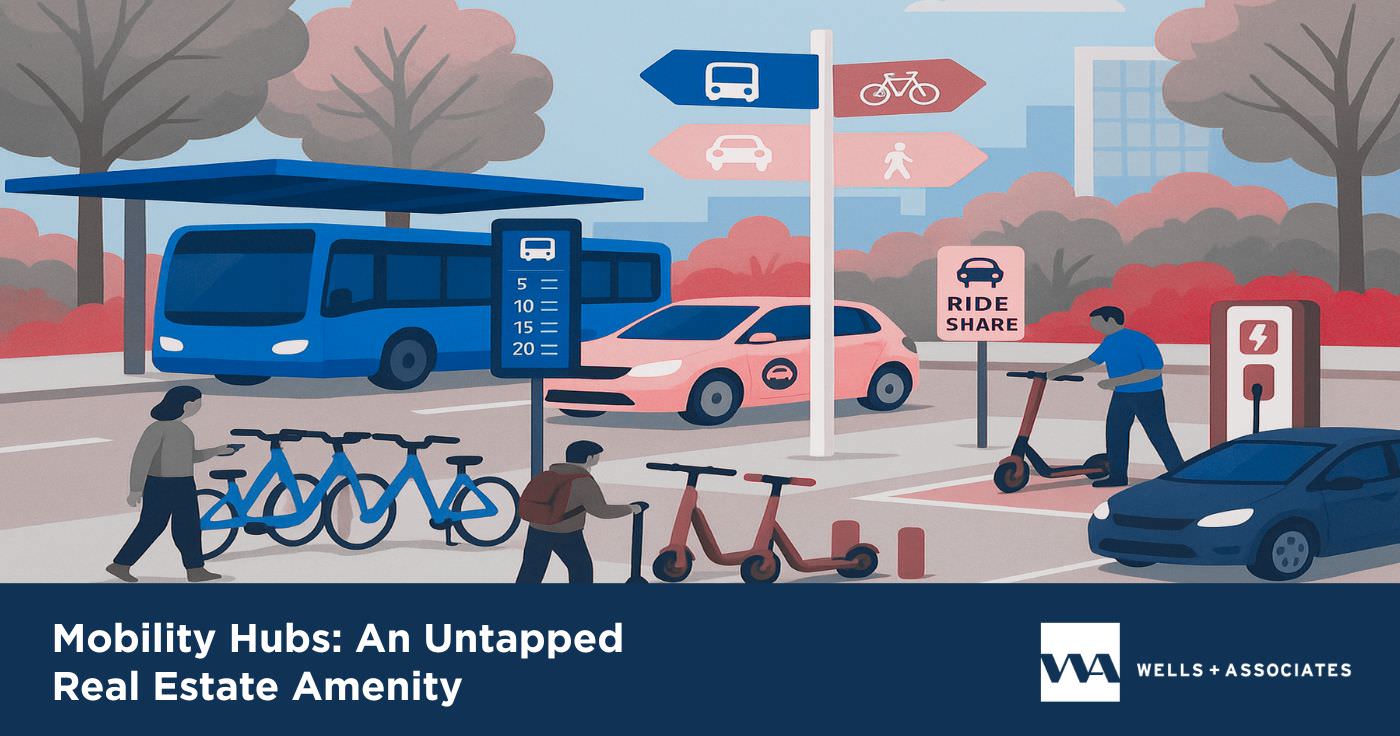In real estate, every square foot has potential value. Real estate developers and owners have an opportunity to leverage often underutilized or unoccupied spaces to offer a new, cutting-edge amenity: mobility hubs. In this article, we discuss how, through the astute design and implementation of mobility hubs, cities, real estate developers, and property owners can enhance transportation offerings, maximize the use of facilities and physical spaces, and gain competitive advantages in the market.
The following discussion is intended to help guide:
- Developers who aim to leverage an area’s rich transportation options while reducing parking development costs,
- Property owners who want to optimize curb space, parking, and mobility amenities to meet evolving tenant demands and gain a competitive advantage in the real estate market, and
- Cities that seek to improve connectivity and encourage multimodal trips for residents and visitors.
We will discuss the following:
- Background: What Is a Mobility Hub?
- Benefits + Competitive Advantages of Mobiity Hubs
- How to Fit Mobility Hubs Into Your Strategic Planning
- Current Examples of Mobility Hubs
- Tangible Ways to Build These New Amenities
To start, what exactly is a mobility hub and what impact can it have on how people travel to, from, and around your site?
Background: What is a Mobility Hub?
A mobility hub is a location where infrastructure or amenities for two or more modes of transportation interact. At their simplest, mobility hubs include park-and-ride facilities or bus stops co-located with bicycle parking. However, mobility hubs are flexible and perform best when they are strategically designed as a focal point that reflects a site’s unique location, end users, and curb demands. By being scaled to the surrounding environment, they may include features such as:
- Ridehailing zones for Uber/Lyft,
- Real-time transit display screens and wayfinding,
- Ease of transfer between modes of transportation
- E-scooter or bikeshare parking,
- Fare and information kiosks,
- Incentivization or connections to supportive commuter programs, and
- Placemaking elements.
Benefits and Competitive Advantages That Mobility Hubs Bring to Developers and Property Owners
Mobility hubs can and should be considered by real estate developers and property owners for several reasons that maximize service to residents and visitors, adding value to a site, including:
- Enhanced curb management,
- Improved connectivity across transportation services and modes,
- Heightened positive perception by tenants, visitors and the public,
- Reduced parking footprint, thereby reducing costs and increasing utilization of space, and
- Opportunities for increased revenue.
Opportunities to expand tenant amenities and get more value from properties include:
Curb Management
A mobility hub can create “zones” for different uses – such as ridehailing, delivery services, and scooter parking – that would typically all occur at one location to ease management of various services while also amenitizing available space.
Connectivity
A mobility hub increases connectivity across various transportation services which can help properties facing first/last-mile challenges by offering designated space and options for multimodal trips.
Visibility + Tenant or Visitor Attraction
Mobility hubs can be highly visible and serve as a public good in addition to supporting a site’s residents and employees. They often include placemaking strategies and amenities which can improve user experiences, increase dwell time, and attract potential new tenants or visitors.
Reduce Parking Footprint
By creating a mobility hub that encourages and supports walking, biking, public transit, and modes of transportation other than a personal vehicle, a developer may be able to include less parking by showcasing other means of meeting tenant transportation needs.
Revenue Opportunity
Just like a site may charge for parking, depending on the amenities located at the site, some revenue opportunities may be realized. For example, a site operating a shuttle or a closed bikeshare or e-scooter network may allow tenants to ride for free while charging visitors or other users for the service.
Strategic Planning: Building Mobility Hubs That Align with Business Goals
A number of important considerations support the design of a robust mobility hub. We believe that the best outcomes proceed from taking a strategic approach so that a new mobility hub will align with corporate goals. For example, developers and property owners should consider:
- What are the goals and how does a mobility hub achieve these goals?
- Who is the audience that will be utilizing this and what do they want and need?
- Based on the goals, audience, and location, what transportation options need to be considered?
- What amenities, technology, placemaking, and services could improve the experience and make it easy to choose these options?
- How are we promoting this feature or helping people get to and from it?
- What does success look like for this project and how are we measuring its impact?
Current Examples of Mobility Hubs
Mobility hubs have been around for some time and often found in the public sector at city-managed bus stops and transit stations. However, they are becoming increasingly prevalent in university and mixed-use developments as the demand for curb space and mobility options evolves.
- Gateway Mobility Hub: Connects lower and upper campuses of the Oregon Health & Science University (OHSU), offering aerial tram connectivity between campuses, paratransit drop-off zones, bikeshare docking stations, streetcar and bus stops, along with various types of bicycle parking, scooter parking, and placemaking elements.
- Culdesac Tempe, AZ: The mixed-use development which boasts car-free living and zero parking features scooter parking, carshare, and a designated pick-up drop off zone across the street from a light rail station. The property also offers residents unlimited free metro rides, on-site scooters, and free and discounted Waymo rides.
- University of California, Riverside: The university has plans to develop a mobility hub featuring bus bays, passenger drop-off areas, pedestrian paths, and other improvements in a central location.
Thinking Ahead: Tangible Ways That Mobility Hubs Can Be Enhanced and Leveraged as a Real Estate Amenity
So how can real estate developers and owners leverage often underutilized or unoccupied spaces to offer a new, cutting-edge amenity? Tenants can use mobility hubs daily as they travel to and from the property – extending the tenant experience beyond the physical space.
For example, mobility hubs can help turn an unoccupied retail space into a hub of activity where tenants can:
- Utilize proptech features and real-time transportation information to plan their commute before they walk out the door
- Check out an e-scooter or bike for their trip
- Grab last minute needs such as a helmet, umbrella, or a snack
- Receive or purchase passes or memberships to use on various mobility services
- Pick up packages, dry cleaning, and/or food delivery service on their way in or out
- Wait for shuttles, transit, ridehailing (e.g. Uber, Lyft), or valet services
Customized mobility hubs enable developers and owners to extend beyond the retail space to create curbside zones for carshare, ridehailing service pick-ups, shuttle service, deliveries, and/or dockless mobility options.
The fact is that a person’s decision about where they live or work is largely based on their commute and a property’s location. Designed and implemented properly, property mobility hubs can have the unique ability to either leverage a site’s transit-friendly location or shift the commute from being a barrier to an engaging amenity depending on your goals and audience. As property amenities and mobility options evolve, a key question to ask is: What would your mobility hub need to include to expand the tenant experience?
As mobility choices evolve and the role of tech expands, it is important to consider how your development is incorporating forward-thinking infrastructure and spaces that leverage transportation as an amenity. Our Mobility Management + TDM team helps developers and property owners take a thoughtful approach to parking and mobility challenges that future-proofs transportation needs and supports sustainable shifts in travel behavior.
Contact our Mobility Management Team
Marie Cox, TDM-CP
Principal | (703) 676-3629
An accomplished sustainable mobility consultant, Marie Cox works closely with commercial and residential real estate properties and developments to leverage transportation programs and amenities to enhance sustainability, gain a competitive advantage, and attract tenants.
Courtney J. Menjivar
Vice President | (703) 676-3636
cjmenjivar@wellsandassociates.com
Courtney Menjivar is a passionate global implementer of Transportation Demand Management (TDM) programs. TDM programs aim to reduce reliance on single-occupancy vehicles, giving more transportation choices to commuters and raising the value of real estate developments.



